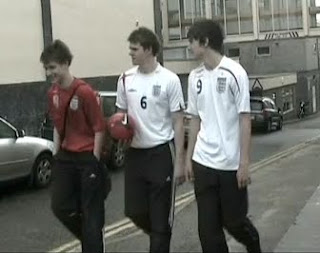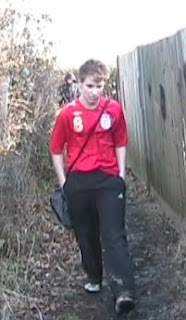Genre
· This film comes under the ‘Crime Thriller’ genre
· The opening sequence follows residual expectations of the crime thriller genre as it starts with a crime, the manufacturing and exportation of drugs. There is a clue to one of the main characters in the film early on as it shows how one man owns the drugs and is making sure that everything is going to plan.
· The text seems to stay within the boundaries of the genre as most crime thrillers involve a crime, the laundering of drugs, and have a main ‘bad guy’ who the audience will be against.
Film Language
· During this sequence, there are a lot of props used to convey that it is a crime thriller. The fact that the opening shot is of a scientist manufacturing drugs shows that the film will involve these, the opening screen tells the audience early what is going on as it states the destination, ecstasy lab. The use of coffins signifies death, filling them with drugs is ironic as they can be the cause of it. The first shot of the owner of the drugs is of him in an expensive looking house, this shows the audience that he has lots of money and usually some sort of power comes with money.
· There are a lot of CUs of the drugs and manufacturing process, this helps to show exactly what they are as the pills are small. The camera looks up when pointing at the man in charge of the drugs to show how he has a status and power.
· During this sequence, there is background music, this ads depth the scene and also tension. The quick tempo of the music allows it to fit in with the fast cutting rate.
· The first line of dialog used is ‘ya, all this is under control’, this signifies that an operation is being performed and that it has some level of importance. The other line of dialog used allows the audience to realise who is behind the operation, and the money stated lets them know that he is very rich and so powerful.
· The director uses a blue filter at the start when showing the pills, this ads some sort of disorientation, it also means that the opening shots have some colour not just grey and white.
Narrative
· The narrative starts with the manufacturing of drugs and goes to show them being transported and moved to a different country. This explains that the story will probably be about those drugs and what is happening around them.
· The audience in the narrative if positioned against the drug owner, the way he looks and sounds makes him easy to dislike, also the way he mentions his money could make people jealous as he is very rich.
· The major themes in the opening sequence is crime, from the use of drugs you can tell that the film will be based around these and as the genre is crime thriller you can tell there is going to be some sort of investigation or arrest over these drugs.
· Tension is kept through the sequence through the use of music, also the fact that it can be seen that a lot of drugs are being produced, the use of long shots of the drugs show this. The lack of dialog builds tension as when you see people working together u expect them to be talking but there are only two lines of dialog in the whole opening sequence.
Representation & Ideology
· The social groups represented in the sequence are youths as they are most commonly thought of as involved with drugs, also with criminals as they are represented in the fact that there is a mass crime taking place.
· During the Process of making drugs, there is never any sign of the feel of wrong doing in any of the characters. This backs up the ideology that criminals don’t really care about the crime, just the money. It shows that the values of the criminals are low and that they only care about themselves and no one else.
· In the opening part of the film, the general characteristics of crime thriller films are followed; these are usually setting up the crime and introducing main characters. Although some crime thrillers reveal the plot early and then build up to it, in this film, the plot is not reviled in the opening sequence so the audience are kept in suspense over what will happen.
Media Audiences
· I feel the target audience for this film is young males, as the certificate is 15; I feel the main age range is 15-21.
· One possible way audiences read the text will be that they see that a crime is going to take place so they understand immediately what is going on. People could watch the opening of the film and feel that violence will be involved as that’s what drugs can lead too.
· When I see this text, I read it as a regular crime thriller. I see the drugs and hear the music and it seems similar to most other films in the genre, I feel my age and gender does not affect this much neither does my background.
Institutional context
· In this film there are 2 big name actors used, Martin Lawrence and Will Smith are both police officers, the fact that the two most famous actors are both on the same side positions the audience with them as they can relate to them and are familiar with them.
· This film was distributed by ‘Sony Pictures’. This makes it an industrial film.
This film is a sequel to ‘Bad Boys’, this means that the name is already familiar. The use of viral marketing with a website and trailers sent out helped advertising the film

 This is our call sheet and Risk Assessment. The call sheet helped us organise where we were planning the shoot and and at what time would do so. It was filled out before we rented our camera equipment so that we were able to pre-plan the shoots and make sure everyone involved knew who was responsible for the equipment.
This is our call sheet and Risk Assessment. The call sheet helped us organise where we were planning the shoot and and at what time would do so. It was filled out before we rented our camera equipment so that we were able to pre-plan the shoots and make sure everyone involved knew who was responsible for the equipment.




 happened earlier that day, flashing back to where he is fine to further represent him as a normal kid. Also the mirror shot and his arrogant remark was to show the type of charcter he is, and his peers' facial expressions show what people think of him. We did all our needed to shots to the level that we wanted, which left us adequate time to edit it.
happened earlier that day, flashing back to where he is fine to further represent him as a normal kid. Also the mirror shot and his arrogant remark was to show the type of charcter he is, and his peers' facial expressions show what people think of him. We did all our needed to shots to the level that we wanted, which left us adequate time to edit it.































